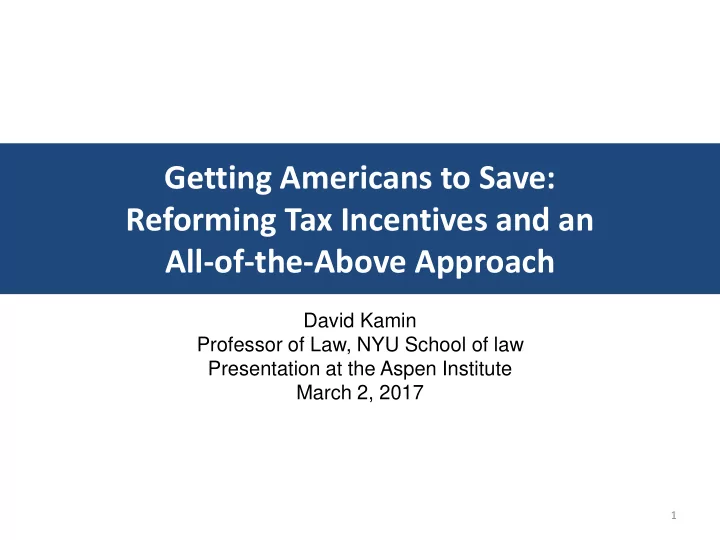

Getting Americans to Save: Reforming Tax Incentives and an All-of-the-Above Approach David Kamin Professor of Law, NYU School of law Presentation at the Aspen Institute March 2, 2017 1
Significant Share of Americans Americans Appear to Under-Save National Retirement Risk Index, 2013 Target Income Percent Under- Replacement Rate Saving at Age 65 ("At Risk") Low Income 80% 60% Middle Income 71% 52% High Income 67% 43% Source: Center for Retirement Research at Boston College, National Retirement Risk Index, 2014 2
Rise of Tax-Preferred Retirement Accounts Distribution of Tax Preferred Retirement Saving by Type Source: Council of Economic Advisers, 2015 3
Rise of Tax-Preferred Retirement Accounts Tax Expenditure Cost, 2016 (Billions) Defined Contribution (NPV) $72 Defined Benefit (NPV) $31 IRAs/Roth IRAs/SEPs (NPV) $12 Savers Credit $1 Source: Treasury Dep't. tax expenditure estimates. 4
What’s the Effect of Tax -Preferred Accounts? 5
What Happens in Denmark Doesn’t Stay in Denmark Effect of New 14% Tax On Contributions to Retirement Saving Per Dollar Contributed to Accounts Active Savers Passive Savers Population as Whole Future Consumption 16 Cents per $ 0 8 Cents Per $ Current Consumption 0 14 Cents Per $ 7 Cents Per $ Author's calculations based on Chetty, Friedman, et al. Study looks at the effect of an incremental change in incentive over a relatively tight income range in Denmark. Doesn’t directly inform effects of accounts overall or across wider distribution. 6
Lack of Access/Participation Illustration of the problem: Significant share of population do not have any assets in a retirement account. Source: Nari Rhee, National Institute on Retirement Security, 2014. 7
Allocation of Current Tax Benefits Distribution of Tax Benefits for Retirement Tax Incentives (NPV, 2016) Expanded Cash Benefit as a Percent of Share of Total Income Percentile After-Tax Income Benefit Lowest Quintile 0.1 0.5 Second Quintile 0.6 3.8 Middle Quintile 1.1 10.7 Fourth Quintile 1.6 22.5 Top Quintile 2.0 62.6 All 1.5 100.0 Addendum 80-90 2.2 20.3 90-95 2.6 16.1 95-99 2.7 20.0 Top 1 Percent 0.7 6.2 Top 0.1 Percent 0.1 0.6 Source: Urban-Brookings Tax Policy Center, Table T16-0161 8
Allocation of Current Tax Benefits (contd.) 9
Path Forward: An Agenda for Reform 1. Distribution. Refocusing the current tax incentives on low and middle income Americans whose saving behavior would be most sensitive to these incentives. There have been a number of proposals in this vein including enhancing or replacing the current subsidy system with refundable tax credits. Eliminating “gaming” opportunities. 2. Universality/portability. Simplifying the system by establishing universal savings accounts that are easily portable from workplace to workplace and into which all workers are defaulted. 3. Defaults. Carefully studying optimal default saving rates and using ones that are probably higher than now exist in many workplaces. Looking beyond tax incentives: Saving floors (in form of Social Security) key aspect of system and should be strengthened. All tools — Social Security, incentives, defaults — work in concert. 10
Recommend
More recommend